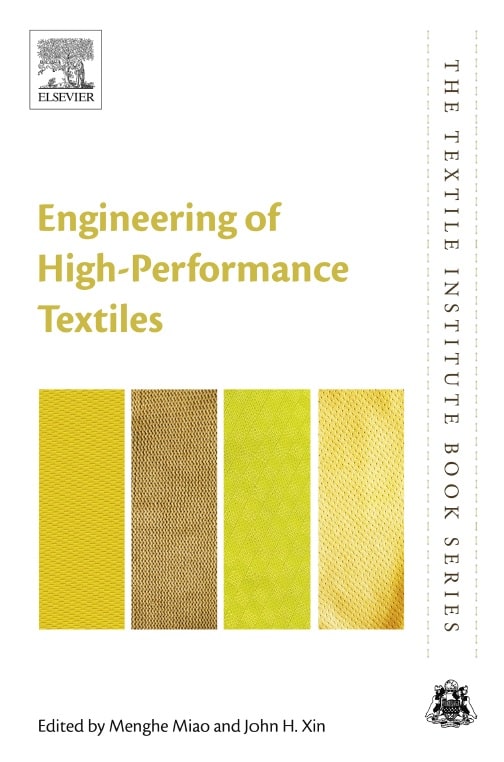
Contents
List of contributors xi
Preface xiii
Part One Product design 1
1 Fiber selection and substitution 3
M. Miao, S. Gordon
1.1 Introduction 3
1.2 Fiber fineness 5
1.3 Fiber length 9
1.4 Fiber crimp 10
1.5 Tensile properties 11
1.6 Thermal conductivity 15
1.7 Moisture absorbency 16
1.8 Static electricity 17
1.9 Fiber substitution 18
References 24
Further reading 26
2 High-performance fibers for textiles 27
B. Fei
2.1 High-strength fibers 27
2.2 Temperature regulating fibers 34
2.3 Moisture control fibers 38
2.4 Elastic fibers 43
2.5 Radiation shielding fibers 47
2.6 Flame retardant fibers 49
2.7 Summary 55
References 55
3 Fiber blending 59
M. Miao
3.1 Purposes of fiber blending or mixing 59
3.2 Methods of blending 60
3.3 Blending effects 64
3.4 Examples of blended textiles 68
References 77
4 Fiber-to-yarn predictions 81
S. Yang, S. Gordon
4.1 Introduction 81
4.2 Fiber quality indices 82
4.3 Theoretical models 84
4.4 Models used in industry 88
4.5 Databases 89
4.6 Validation of Cottonspec results 100
4.7 Conclusion 103
References 104
5 Fabric structures: Woven, knitted, or nonwoven 107
H. Gong, B. Ozgen
5.1 Introduction 107
5.2 Woven fabrics 107
5.3 Knitted fabrics 115
5.4 Nonwoven fabrics 124
References 130
Further reading 131
6 Woven fabric structures and properties 133
B. Kumar, J. Hu
6.1 Introduction 133
6.2 Introduction to woven structures 134
6.3 Geometrical analysis to woven fabric structures 137
6.4 Influence on fabric properties—By structural modifications 144
6.5 Mechanical properties of woven fabric 145
6.6 Influence of 3D woven structures on fabric properties 149
References 150
Part Two Performance enhancement 153
7 Colorfastness 155
K.R. Millington
7.1 Introduction 155
7.2 Factors affecting colorfastness 156
7.3 Colorfastness properties of specific fiber-dye systems 168
7.4 Finishes to improve colorfastness 172
7.5 Assessment of colorfastness 174
7.6 Future trends 183
7.7 Sources of further information and advice 184
Acknowledgment 184
References 184
8 Easy-care treatments for fabrics and garments 187
J.H. Xin, H.F. Lu
8.1 Introduction 187
8.2 Definition of easy-care properties and test methods 189
8.3 Development of easy-care finishing technology 190
8.4 Future perspectives 213
References 214
9 Pilling-resistant knitwear 217
L. Wang, X. Qian
9.1 Introduction 217
9.2 Pilling assessment 219
9.3 Factors affecting pilling 222
9.4 Pilling management for knitwear 224
9.5 Pilling of synthetic and blended textiles 226
9.6 Summary 227
References 228
Further reading 229
10 Warmth without the weight 231
Y. Ke, F. Wang
10.1 Introduction 231
10.2 Mechanisms of heat transfer through textiles 231
10.3 Representation of heat transfer properties of textiles 234
10.4 Heat transfer and air gap trapped within the clothing microclimate 236
10.5 Parameters related to heat transfer through textiles 237
10.6 Evaluations methods of the heat transfer property of textiles 239
10.7 Conclusions and future trends 241
References 241
Sources for further information 245
11 Moisture absorption and transport through textiles 247
F. Wang
11.1 Introduction 247
11.2 Moisture transfer through textiles 247
11.3 Test methods and standards 251
11.4 Modeling of moisture transfer through textiles 266
11.5 Engineering of moisture management textiles 267
11.6 Conclusion 269
References 270
Sources of further information 274
Part Three Product specialization 277
12 Compression and stretch fit garments 279
A. Yu, K.L. Yick
12.1 Introduction 279
12.2 Compression and stretch fit apparel 280
12.3 Design and development of compression sportswear 287
12.4 Factors affecting compression performance 288
12.5 Physiological and psychophysical effects of compression garments on humans 296
12.6 Future trends 297
Acknowledgments 297
References 298
Further reading 303
13 Conductive textiles 305
K. (Kelvin) Fu, R. Padbury, O. Toprakci, M. Dirican, X. Zhang
13.1 Introduction 305
13.2 Antistatic textiles 305
13.3 EM shielding textiles 307
13.4 E-textiles 314
13.5 Functional coatings 317
References 327
Further reading 334
14 Insect-repellent textiles 335
J.H. Xin, X.W. Wang
14.1 Introduction 335
14.2 Development of insect-repellent textiles 336
14.3 Testing and evaluation of insect-repellent textiles 341
14.4 Issues and challenges 344
14.5 Conclusions 346
References 347
15 Camouflage fabrics 349
R.J. Denning
15.1 Introduction 349
15.2 Detection technologies 352
15.3 Textiles for camouflage 356
15.4 Future trends 368
References 371
16 Impact-resistant fabrics (ballistic/stabbing/slashing/spike) 377
K. Bilisik
16.1 Introduction 377
16.2 Fibers, matrices, and nanoadditives 378
16.3 Threat and protection 383
16.4 Impact theory 390
16.5 Fabrics for impact 393
16.6 Impact properties of fabrics and composite structures 404
16.7 Main failure modes in ballistic fabric structures 415
16.8 Repair of ballistic structures 416
16.9 Ballistic structure design examples 417
16.10 Future trends 423
16.11 Conclusion 424
16.12 Sources of further information and advice 424
Acknowledgments 424
References 425
17 Engineering design of high-performance filter fabrics 435
N. Mao
17.1 Introduction 435
17.2 Factors affecting the performance of filter fabrics 437
17.3 Engineering design of filter fabrics 441
17.4 Overview of filter fabrics 466
References 477
Further reading 487
18 Fabrics for reinforcement of engineering composites 489
C. Greb, C. Lenz, M. Lengersdorf, T. Gries
18.1 Composites—Introduction 489
18.2 Textile characteristics relevant for composites 492
18.3 Woven fabrics 493
18.4 Noncrimp fabrics (NCFs) 501
18.5 Braids 501
18.6 Tailored reinforcement textiles 506
References 508
Further reading 512
Index 513
